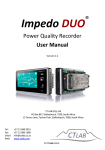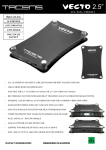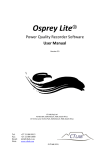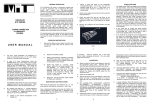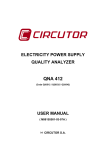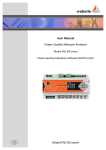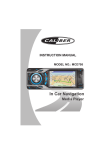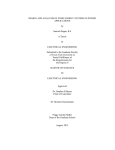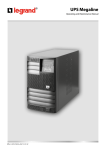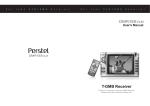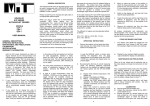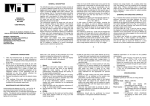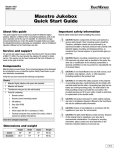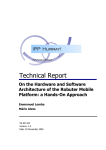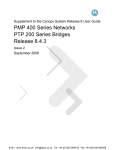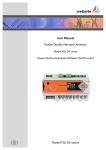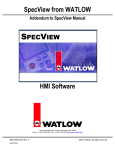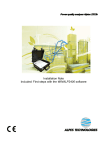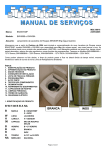Download Vecto II - CT LAB Power Quality
Transcript
® Vecto II Power Quality Recorder User Manual Version 1.1 CT LAB (Pty) Ltd PO Box 897, Stellenbosch, 7599, South Africa 15 Termo Lane, Techno Park, Stellenbosch, 7600, South Africa Tel: Fax: Email: Web: +27 21 880 9915 +27 21 880 1088 [email protected] www.ctlab.com © CT LAB (2015) Table of Contents 1 Safety Instructions 6 1.1 Symbols .........................................................................................................6 1.2 Safety Standards Compliance..................................................................6 1.3 General Safety Information .....................................................................7 1.4 Statements and Notices ............................................................................8 1.4.1 Statement of reliability................................................................................... 8 1.4.2 Proprietary rights ............................................................................................ 8 1.4.3 Copyright ............................................................................................................ 8 1.4.4 Trademarks........................................................................................................ 8 2 Introduction to the Vecto II 9 2.1 Vecto II Product Description ...................................................................9 2.2 Receiving your Vecto II .............................................................................9 2.2.1 Receiving your shipment............................................................................ 10 2.2.2 Unpacking the goods .................................................................................... 11 2.2.3 Checking the Battery Level ........................................................................ 11 2.2.4 Return shipment ........................................................................................... 12 2.3 Instrument Overview ............................................................................. 12 2.3.1 Key Features ................................................................................................... 12 2.3.2 Vecto II External Interfaces ....................................................................... 14 2.3.3 Power sources ................................................................................................ 15 2.3.4 Communication.............................................................................................. 15 2.3.5 Osprey Pro (Enterprise Support) ............................................................ 16 2.3.6 Sampling Rate................................................................................................. 16 2.3.7 The 1/6th Sense .............................................................................................. 16 Vecto II User Manual 2 2.3.8 Event Recording ............................................................................................ 17 2.3.9 10/12-Cycle Block Recording ................................................................... 17 2.3.10 Variable time interval trends .................................................................... 18 2.3.11 Synchrophasors ............................................................................................. 18 2.3.12 Measured parameters ................................................................................. 18 2.3.13 Technical Specification................................................................................ 22 2.4 Vecto II External Interfaces .................................................................. 25 2.4.1 Physical Appearance .................................................................................... 25 2.4.2 Vecto II User Interface................................................................................. 27 2.4.3 Power Supply ................................................................................................. 27 2.4.4 Voltage Inputs ................................................................................................ 30 2.4.5 Current Inputs ................................................................................................ 32 2.4.6 Current Transducer Inputs ........................................................................ 34 2.4.7 Relay Outputs ................................................................................................. 35 2.4.8 Digital inputs .................................................................................................. 36 2.4.9 GPS ..................................................................................................................... 38 2.4.10 Ethernet Ports ................................................................................................ 38 2.4.11 USB Peripheral Ports ................................................................................... 40 2.5 Firmware ................................................................................................... 40 2.5.1 3 Upgrading ........................................................................................................ 40 Operating Instructions 41 3.1 Precautions when first using the device ........................................... 41 3.2 Toggling Storage/Ready Mode ............................................................ 41 3.3 Interpretation of Status LEDs .............................................................. 43 3.4 Powering up the VectoII ........................................................................ 44 3.4.1 Powering up from Storage Mode ............................................................. 44 3.4.2 Powering up from Ready Mode................................................................ 44 Vecto II User Manual 3 3.5 Shutting down .......................................................................................... 44 3.6 Error Conditions ...................................................................................... 45 3.6.1 Health Failure Conditions .......................................................................... 45 3.6.2 Recovery conditions..................................................................................... 45 4 Vecto II Installation 47 4.1 Mounting the Vecto II ............................................................................. 47 4.1.1 Panel Mounting Installation ...................................................................... 47 4.1.2 19” Rack Mounting Installation................................................................ 48 4.1.3 DIN rail mounting ......................................................................................... 48 4.2 Connections .............................................................................................. 49 4.2.1 AC Power.......................................................................................................... 49 4.2.2 Power Over Ethernet ................................................................................... 50 4.2.3 Voltage connections ..................................................................................... 50 4.2.4 Current connections..................................................................................... 55 4.2.5 Ethernet Based Communication .............................................................. 60 4.2.6 GPS ..................................................................................................................... 60 5 Maintenance 61 5.1 Battery ........................................................................................................ 61 5.2 Transport................................................................................................... 61 5.3 Storage ....................................................................................................... 61 5.4 Warrantee and Repair ........................................................................... 62 5.4.1 Warrantee Statement .................................................................................. 62 5.4.2 Technical Support ......................................................................................... 63 5.4.3 Sales Assistance ............................................................................................. 63 5.4.4 Repair and Calibration ................................................................................ 63 Appendices 65 1 65 Vecto II dimensions Vecto II User Manual 4 2 Vecto II wiring diagram 66 3 Vecto II rating plate (Back plate) 67 4 Accessories and Options 68 5 Glossary 72 6 Symbols and Abbreviations 73 Vecto II User Manual 5 1 Safety Instructions This section provides information on safe handling, installation and commissioning of the Vecto II. Before carrying out any work on the equipment the user should be familiar with the contents of this document. Reference should be made to the instrument’s wiring diagram and the ratings before any installation can commence. 1.1 Symbols 1. 2. Notice Used to call attention to important information. Caution Used to indicate operating or maintenance procedures to be respected in order to prevent damage or destruction of equipment. Warning Used to call attention to potential dangerous situations or danger in general, that requires specific procedures to be respected in order to prevent personal injury. 1.2 Safety Standards Compliance The instrument comply to the IEC61010-1 safety standard: Pollution: Degree 2 Over-voltage category: CAT III Measurement category: CAT III The instrument comply to the IEC60529 protection standard: Vecto II Penetration of dust & water: Class I IP Rating: IP52 Inadvertent contact User Manual 6 1.3 General Safety Information Installation and maintenance of the instrument should only be performed by a qualified and certified electrician/technician with appropriate training and experience with high voltage and current devices. The instrument must be installed in accordance with the approved national electrical codes. If the instrument is used in a manner not specified by the manufacturer, protection from electric shock, fire, etc. provided by this equipment may be compromised. When the instrument is in operation, dangerous voltages will be present in certain parts of the equipment. Failure to observe warning notices, incorrect use, or improper use may endanger personnel and the instrument and also cause personal injury or physical damage. The terminals exposed during installation, commissioning and maintenance may present a hazardous voltage unless the equipment is electrically isolated. Failure to properly isolate the instrument can create a risk of electric shock, injury or death. Failure to earth the instrument will compromise the correct functioning of the internal protection circuitry of the instrument. During normal operation, hazardous voltages are present on the connector terminals. The standard safety precautions must be followed while performing both the installation and service work. The user must inspect the instrument and all accessories before use; attention must be placed on inspecting: Damage to instrument and accessories – do not use any damaged equipment. The rating of the input terminals – Do not apply input voltages above the rating of the Instrument. Do not expose the instrument to extreme moisture and or rain. Avoid use should the instrument be exposed to moisture/rain. The digital output of the instrument must not be used for primary protection functions. The digital outputs can however be used for secondary protection functions. Vecto II is intended for indoor installation and use only. If it is required for use in an outdoor environment then it must be mounted in a specific cabinet or housing which will enable it to meet the requirements of IEC 60529 with the Vecto II User Manual 7 classification of degree of protection IP54 (dust and splashing water protected). Do not use the instrument in situations where failure of the instrument can cause injury or death, or cause sufficient energy to be released that can start a fire. 1.4 Statements and Notices 1.4.1 Statement of reliability The information in this manual has been reviewed and is believed to be entirely reliable, however, no responsibility is assumed for any inaccuracies. All material is for informational purposes only and is subject to change without prior notice. Please see www.ctlab.com for the latest copy of this document. 1.4.2 Proprietary rights This publication contains information proprietary to CT Lab (Pty.) Ltd. By accepting and using this manual, you agree that the information contained herein will be used solely for the purpose of operating equipment of CT Lab (Pty.) Ltd. 1.4.3 Copyright No part of this publication may be reproduced, transmitted, transcribed, stored in a retrieval system, or translated into any language or computer language, in any form, by any means, electronic, mechanical, magnetic, optical, chemical, manual, or otherwise, without the prior written consent of CT Lab (Pty.) Ltd., 15 Termo Lane, Techno Park, Stellenbosch 1.4.4 Trademarks Impedo DUO, Vecto II, Osprey Lite, Osprey Pro, Xross-Trigger, Snapshot and 6thsense are registered trademarks of CT Lab (Pty.) Ltd. Vecto II User Manual 8 2 Introduction to the Vecto II This chapter introduce the Vecto II ®. The latest version of this document is shipped with the instrument but all new releases are available at www.ctlab.com. 2.1 Vecto II Product Description The Vecto II is a single feeder version of the Vecto II, but without a display. It is a comprehensive multi-function IEC 61000-4-30 Class power quality recorder with GPSlocked time synchronisation. It has 4 x voltage, 4 x current sensor and 4 x powered current transducer inputs. The Vecto II has an on-board GPS, 2 x Gigabit Ethernet ports, a USB2.0 (HS) expansion port, 4 x digital inputs (5V power available) and 4 x digital outputs. 2.2 Receiving your Vecto II The Vecto II packaging is shown Figure 1 with the high-density foam cavity for the Vecto II and the accessories supplied with the instrument. Figure 2 shows the sealed ImpedoDUO box that is shipped. Vecto II User Manual 9 Figure 1: Inside of the Vecto II box Figure 2: Closed and strapped Vecto II box 2.2.1 Receiving your shipment Upon receiving your Vecto II shipment check the following: Vecto II Outside o o o Inside o o o o Box is seal Box is not damaged Box has no water damage Vecto II in a plastic enclosure Vecto II has no water damage or damp in the plastic enclosure Vecto II screen is intact and has no cracks Ethernet cable, Flash drive and the screw driver is included in the box User Manual 10 If the shipment is damaged or not in a working condition, please take a picture of the damage and send the pictures to [email protected] as soon as possible. Please also phone CT Lab on +27 (21) 880 9915 to handle the problem as soon as possible. 2.2.2 2.2.3 Unpacking the goods Step Action 1 Remove all literature inside the box on top of the highdensity foam 2 Remove the accessories in the accessories cavity on the right side of the box. Check that the standard accessories (see section 2.2.1) are included. 3 Carefully remove the lid of the high-density foam enclosure 4 Remove the Vecto II from the cavity and inspect for damage Checking the Battery Level After calibration and testing, the Vecto II is switched off by means of the Power Button. It disconnects the battery. The instrument will not power up from the battery until mains power is connected to the instrument for the first time. When the instrument is connected to mains power (90-300V AC or DC) press the Power button, check that the power LED starts to flash and that the battery charge LED is on. If the battery LED is switched off the battery is fully charged. The instrument will not power up from the battery until mains power is connected to the instrument for the first time Vecto II User Manual 11 2.2.4 Return shipment Should the instrument be returned to CT Lab for calibration or repairs please follow these instructions: 1. Insert the instrument into a plastic bag to prevent water damage during shipment transit; and 2. Protect the instrument properly and also put it inside a padded box to prevent mechanical damage during transit. 3. Complete the fault report and sent it and the instrument to CT Lab. o Notify [email protected], provide details on the instrument and how it was shipped and how it can be tracked and with a copy of the fault report. The package and instrument remain the responsibility of the client until delivered to CT Lab. 2.3 Instrument Overview 2.3.1 Key Features The Vecto II records both voltages and currents of a single 3-phase feeder with IEC 61000-4-30 Class A performance. 1. Vecto II Voltage inputs: Class A performance over all of the input range inclusive of 63.5 V (if LN measurements are done in a 110 V line-line VT circuit) 6 terminals are used for 4 voltage input channels with maximum input ratings of 600 V. o The first 4 terminals connect 3 different phase voltages such as in a 3-phase system. o Input channel 1-3 is referenced to a neutral (4th terminal) connection. This 4th terminal acts as a reference channel and can be any phase voltage if a 3-phase line-line voltage circuit is measured. o If it is a 3-phase line-neutral voltage circuit, then the 4th terminal will be connected to the neutral voltage. User Manual 12 The 5th and 6th terminal is the 4th channel and a fully differential (2 terminal) input channel. Current inputs: 4 X 1/5 A CT inputs 4 X 1 Vrms differential voltage transducer inputs with a 5 V power supply (to be used to power Rogowski coils). Digitisation of input signals 500 kHz sampling of primary input signals. 50 kHz is digitally retained and subjected to the IEC 61000-4-30 Class A signal processing requirements. Power supply PoE and/or a 90-300 V AC/DC power factor corrected power supply. 4 1/2 hour power failure ride-through via an internal LiFePO battery. Data storage 4 GB on-board storage providing data storage of all IEC 61000-4-30 rd voltage and current 10-minute values up to the 63 harmonic component. Time stamping GPS time synchronization resulting in a time-stamping certainty better than 100 ns. PTP time synchronization resulting in a time-stamping certainty better than 1 ms. NTP time synchronization as an option. Communication Communication is via Ethernet. Modbus over Ethernet. DNP3 over Ethernet. IEC 61850 – optional. Advanced triggering User-configurable triggering between different instruments: the patented Xross-Trigger feature (Described in the OspreyLite user manual) Configuration of instrument The Vecto II has to be configured by means of an Ethernet connection to a local laptop with Osprey Lite installed. o 2. 3. 4. 5. 6. 7. 8. 9. Vecto II User Manual 13 10. Data analysis and reporting Osprey Lite is supplied free of charge and continuously updated. Download from www.ctlab.com. It generates both NRS 048 and EN 50160 PQ reports. It allows basic and advanced analysis of PQ waveform events and trends. Data can be exported to in .csv and PQDIF format for additional analysis in third party software packages. Data downloading can be automated by configuration of the Vecto II with Osprey Lite. 2.3.2 2.3.2.1 Vecto II External Interfaces Voltages The voltage inputs to the Vecto II interface directly to 110 V VT circuits or directly to a mains connection, which has to be less than 600 V line to neutral. Voltage measurements are differential. 6 input terminals for voltages are used. The first 4 terminals are used for 3 voltage inputs V1, V2 and V3 and are neutral (Vcom) referenced (V1-N, V2-N, V3-N). Input channel 1-3 is referenced to a neutral (4th terminal) connection. This 4th terminal acts as a reference channel and can be any phase voltage if a 3phase line-line voltage circuit is measured. If it is a 3-phase line-neutral voltage circuit, then the 4th terminal will be connected to the neutral voltage. The 5th and 6th terminal is the 4th differential channel. o Vecto II It can be used to for example measure the difference between neutral and earth. User Manual 14 2.3.2.2 Currents Permanently installed 1 A or 5 A CT’s, or clamp-on CT’s interface directly to the galvanically isolated current inputs. The instrument calculates the “missing current” by assuming the sum of all currents is zero. (Please refer to Section 2.4.5 for more info) Alternatively, 1 VRMS voltage output current transducers or Rogowski coils with 5 VDC power supply can be used to measure current. Current to voltage transducers can interface directly to 4 low voltage differential inputs. (Please refer to Section 2.4.6 for more info) 2.3.3 Power sources The instrument is powered from a power factor corrected AC supply input (90–300 V AC/DC). It can also be powered from an IEEE 802.3-2008 compliant PoE Plus (< 12 W) source. The internal LiFePO4 battery powers the instrument in the absence of power. This battery guarantees 2,000 charge/discharge cycles. If cycled once per day, it translates to at least a 5-year useful life. Please refer to Section 2.4.3 for more detail. 2.3.4 Communication Two (2) Gigabyte Ethernet ports facilitate local and networked external communication. One port is used to interface with corporate networks (DHCP or fixed IP support). The second Ethernet port is used to create a local network by means of being a local DHCP server. Please refer to Section 2.4.10 for more detail. The remote support software supports automatic service discovery protocols. Laptops, when connected to the Vecto II, will receive an IP from the instrument. The remote support software can automatically discover which instruments are connected to the local network. Please refer to the Osprey LiteTM user manual for more information. Vecto II User Manual 15 2.3.5 Osprey Pro (Enterprise Support) When connected, each instrument automatically establishes a permanent secure communication link to a corporate server (local or internet based). An instrument management system (IMS) keeps track of each instrument’s location, configuration, health (telemetry) and PQ data recorded. Downloading of data is automated and recorded data can be accessed via the Internet in graphical, tabled and report form as and when it becomes available. Raw TM data can be analysed in Osprey Lite or exported for further analysis in for example TM TM Microsoft Excel or Matlab . TM Osprey Lite simplify the analysis of waveform events such as dips and swells by the time-aggregation of multiple waveform events to single network incidents. TM Osprey Lite classify and report on recorded data according to industry standards such as NRS048, EN50160 and IEE1158. All communications are encrypted and each instrument is password protected. More information can be obtained at www.pqportal.com. 2.3.6 Sampling Rate The instrument samples all analog input signals at a rate of 500 kHz (10 000 samples per cycle) and then digitally down-sample the data to 50 kHz (1000 samples per cycle). All IEC 610000-4-30 parameters are calculated based on this 50 kHz resolution for both voltage and current. Waveform and other events are triggered from the 500 kHz digitised waveforms. These waveforms are locked to the fundamental frequency to prevent multiple zero crosses. Captured waveform data can be further subsampled to reduce stored data size. The user can configure the waveform-sampling rate from 1 kHz to 50 kHz. Please refer to the Osprey LiteTM user manual for more information on selecting the down-sampling rate. 2.3.7 The 1/6th Sense The Vecto II calculates a complete set of 1-cycle sliding RMS and fundamental phasor parameters on each of the 3 voltage phases resulting in a resolution of 6 values per cycle per phase. The IEC 61000-4-30 Class A requirements are based on a ½ cycle sliding approach. This higher resolution data improves the detail of the event profile and enable more accurate depth/duration calculations. Vecto II User Manual 16 Please refer to the Osprey LiteTM user manual for more information on 1/6th cycle data. 2.3.8 Event Recording Users can customise the recording of an event. The IEC 610000-4-30 definition of for example a dip event, can be changed to improve the understanding of phenomena of concern. Upper and/or lower thresholds to define an event can be set by the user based on th waveform, 1/6 sense, 10/12-cycle block and aggregated parameters. Single-phase and multiple-phase triggers can be defined. When a threshold is exceeded, the Vecto II will retain pre- and post-diagnostic information of the event. Please refer to the Osprey Lite user manual for more information on event recordings. 2.3.9 10/12-Cycle Block Recording The Vecto II records all RMS and harmonic data from each 10/12-cycle block (≈200ms block) for both voltage and current as prescribed the Class A performance requirements of the IEC 61000-4-30, edition 3. These block values contain both amplitude and angle information of all voltage and current harmonic components up to the 63th harmonic order. Each block is time-stamped with a 1 s time resolution and within a 100 ns time uncertainty1. The user can average N x blocks to reduce the sampling rate for the number of blocks up to 299 blocks2. Please refer to the Osprey LiteTM user manual for more information on 10/12 cycle block intervals and down sampling. 1 When GPS synchronized Averaged block harmonic and unbalance phasors do not contain angle information. Vecto II User Manual 2 17 2.3.10 Variable time interval trends 10/12-Cycle block RMS and harmonic parameters are aggregated according to IEC 61000-4-30 requirements over a user-defined time interval (1 to 30 minutes). Clock synchronised parameters are time-stamped with a 1 second time resolution. 2.3.11 Synchrophasors The Vecto II is also a phasor measurement recorder. Recording of 50 Hz (or 60 Hz) synchrophasors can be activated in the configuration setup. Please refer to the Osprey Lite TM user manual for more information. Note that this can generate large amounts of data. Contact CT LAB for support if interested in a PMU (Phasor Measurement Unit) application. 2.3.12 Vecto II Measured parameters User Manual 18 Aggregated Harmonics Aggregated Inter-Harm ✓ ✓ ✓ ✓ ✓ ✓ ✓ ✓ ✓ ✓ ✓ ✓ ✓ ✓ ✓ ✓ ✓ ✓ 10/12 block th Aggregated Trends 10/12 - Cycle Inter-Harmonics 10/12 - Cycle Harmonics Cycle ✓ - ✓ 1/6 Cycle Waveforms MEASURED PARAMETERS VOLTAGE Frequency (Hz) Voltage (Volt) Voltage (% of Nominal) ✓ Voltage (% of Fundamental) ✓ Voltage Phase Angle (Degrees) ✓ ✓ ✓ Voltage Unbalance (%) ✓ ✓ ✓ ✓ V-Positive Amplitude (Volt) ✓ V-Positive Angle (Degrees) ✓ V-Negative Amplitude (Volt) ✓ V-Negative Angle (Degrees) ✓ V-Zero Amplitude (Volt) ✓ V-Zero Angle (Degrees) ✓ Voltage Under-Deviation ✓ ✓ Voltage Over-Deviation ✓ ✓ Voltage THD ✓ ✓ Flicker (Pst) ✓ ✓ ✓ ✓ ✓ ✓ Flicker (Plt) Vecto II ✓ User Manual 19 ✓ ✓ Aggregated Inter-Harm ✓ Aggregated Harmonics 10/12 - Cycle Inter-Harmonics ✓ Aggregated Trends 10/12 - Cycle Harmonics Cycle ✓ 10/12 block th 1/6 Cycle Waveforms MEASURED PARAMETERS ✓ ✓ ✓ ✓ ✓ CURRENT Current (Ampere) ✓ ✓ Current (% of Fundamental) ✓ Current Phase Angle (Degrees) ✓ ✓ ✓ Current Unbalance (%) ✓ ✓ ✓ ✓ I-Positive Amplitude (Ampere) ✓ I-Positive Angle (Degrees) ✓ I-Negative Amplitude (Ampere) ✓ I-Negative Angle (Degrees) ✓ I-Zero Amplitude (Ampere) ✓ I-Zero Angle (Degrees) ✓ Current THD ✓ ✓ ✓ ✓ ✓ ✓ Crest Factor K-Factor Vecto II ✓ User Manual ✓ ✓ ✓ ✓ 20 Aggregated Harmonics Aggregated Inter-Harm ✓ ✓ ✓ ✓ ✓ ✓ ✓ ✓ ✓ ✓ ✓ ✓ ✓ ✓ ✓ ✓ ✓ ✓ 10/12 block th Aggregated Trends 10/12 - Cycle Inter-Harmonics 10/12 - Cycle Harmonics Cycle ✓ - ` 1/6 Cycle Waveforms MEASURED PARAMETERS POWER Active Power (Watt) Reactive power (VAR) Apparent Power (VA) ✓ Power Angle (Degrees) ✓ Power Factor ✓ ✓ ✓ POWER – IMPORT ✓ ✓ ✓ ✓ Imported Active Power (Watt) ✓ Imported Reactive Power (VAR) ✓ Imported Apparent Power (VA) ✓ Imported Power Angle (Degrees) ✓ Imported Power Factor ✓ POWER – EXPORT ✓ Exported Active Power (Watt) ✓ ✓ Exported Reactive Power (VAR) ✓ ✓ Exported Apparent Power (VA) ✓ ✓ Exported Power Angle (Degrees) ✓ ✓ ✓ ✓ ✓ ✓ Exported Power Factor Vecto II ✓ User Manual 21 2.3.13 Technical Specification VOLTAGE INPUTS th Number of channels 4 x differential inputs (3/4 Wire + 4 Diff) Measurement input range 0 – 600 VRMS Voltage measurement Single Phase, 3-Phase (Star, Delta), DC Input impedance/channel > 1 M CURRENT INPUTS Number of channels 4 x galvanically isolated inputs Measurement input range 0 - 5.0 ARMS Maximum continuous current 6.0 ARMS 3 sec over-current withstand 50 A VA Burden @ 5A < 1 VA Galvanic isolation 1,000 V CURRENT TRANSDUCER INPUTS Number of channels 4 differential inputs Measurement input range 0 – 1.0 VRMS (± 1.414 V Peak) Input impedance/channel > 1 M DIGITAL INPUTS Number of Channels Vecto II 2 sets of 2 galvanically isolated digital outputs User Manual 22 Switch Rating 0.1 ARMS, 300 VRMS (max) ACCURACY & BANDWIDTH Power frequency range DC, 50 HZ (40-60 Hz), 60 Hz (50-70 Hz) Harmonic bandwidth 1-64 (harmonic and inter-harmonic) Measurement sampling rate 0.5 MHz (simultaneously sampled) Waveform storage rate 1 kHz (user configurable) ADC Resolution 16-Bit Overall accuracy class 0.1% Fast Transient Capturing > 20 s th COMMUNICATION Ethernet 2 x Gigabit Ethernet – IEEE 802.3.2008 compliant USB USB 2.0 – 480 Mbit (powered) CLOCKS On-Board GPS On-board 3V3 power for active external antennae Overall Accuracy Class ± 20 s from absolute time On-Board RTC drift 1 ppm (32-seconds per annum) NTP, PTP POWER Maximum Power Consumption Vecto II < 15 W User Manual 23 AC / DC supply voltage input range 90-300 VRMS 42-69 Hz (power factor corrected) Power over Ethernet IEEE 802.3 compliant (35-60 VDC) On-board battery LifePO (2,000 charge/discharge cycles) 4 PHYSICAL Construction Aluminium, 250 x 135 x 65 (L x W x H) Mounting options 3U-19” Rack, Panel Mount, Portable Case Electrical connections Pluggable screw type (screw lock-down) Electrical isolation class 600 V Class II Operating temperature 0 ⁰C to 75 ⁰C COMPLIANCE PQ Measurement IEC 61000-4-30, Class A Harmonics IEC 61000-4-7 Flicker IEC 61000-4-15 SCADA IEC 61850 Vecto II User Manual 24 2.4 Vecto II External Interfaces 2.4.1 Physical Appearance Figure 3 shows the front of the Vecto II. The nameplate displays the name and serial number of the instrument, detail layout of the external interfaces of the instrument and instrument power and On/Off switches. A detail description of the external interfaces is provided in Sections 2.4.2 to 2.4.11. Figure 4 shows the back of the instrument. The Vecto II can be installed as a temporary investigation instrument, be surface mounted or on a DIN rail as respectively shown in Figure 4 a, b and c. Figure 3: Front of instrument Vecto II User Manual 25 a) Investigation instrument rubber foot piece b) Surface mount installation Surface mounting plates c) DIN rail installation DIN rail mounting set Figure 4: Back of instrument Vecto II User Manual 26 USB port Figure 5: Right side of instrument Figure 5 show the USB port located on the right hand side of the instrument. 2.4.2 Vecto II User Interface Figure 6: Right side of instrument Six LEDs on the top-left front side of the instrument provide status information. The interpretation of the status LEDs is discussed in Section 3.2. Two buttons located below the LEDs are used to control the power state of the instrument. The Power button is recessed to avoid accidental switching. It rests flush with the surface plate in the off-state and sits below the surface plate in the on-state. The On/Off button is a push-button that returns to the non-pressed state when released. The use of the buttons is discussed in Chapter 3. 2.4.3 Power Supply The Vecto II can be powered and charged directly from mains (90 – 300 V AC/DC) via a power factor corrected internal power supply. The Vecto II can also be powered and charged via an IEEE 802.3-2008 compliant Power over Ethernet (PoE) power supply. Vecto II User Manual 27 A built in LiFePO4 battery will power the instrument for up to a half an hour in the absence of power. This battery has a design life expectancy of more than 2,000 charge/discharge cycles. The Power Supply port, as shown in Figure 7, contains 3 terminals on a removable/ 2 lockable plug. Each terminal can accommodate conductors with sizes up to 2.5 mm . Neutral Earth Live Figure 7: Vecto II power supply connection Table 1: Power supply connection Terminal Legend Description 1. L Live Terminal 2. E Safety Earth 3. N Neutral Terminal The supply voltage input range is from 90 VRMS to 300 VRMS AC or DC (42-69 Hz for AC sources). The supply current is power factor corrected and the maximum power consumption of the Vecto II is actively limited to 12.5 VA. The Vecto II can be powered directly from 110 V 50/60 Hz VT circuits due to this low burden. Vecto II User Manual 28 The power supply is protected from brief periods of overvoltage conditions by builtin surge protection. An internal electronic fuse protects the Vecto II from over and under voltage. The Vecto II will automatically disconnect from mains if excessive current is drawn from the universal AC/DC supply input port. When this protection was activated, it needs a few minutes to cool, during which the Vecto II will not restart even with valid mains voltage. During a power interruption/failure, the internal battery will power the instrument for ± 30 minutes. When the battery charge drop below 50% of full capacity, the instrument will gracefully shut down to protect the battery from being damaged. When power is restored, the instrument will automatically restart within 15 seconds if the battery status is above 30% or first recharge until the battery reach 30% and only then restart. The Safety Earth terminal connects all exposed metal parts to external earth Port 1 Port 2 Figure 8: Ethernet ports IEEE 802.3-2008 compliant Power over Ethernet (PoE) Plus is available on both Ethernet ports at 48 V. The PoE capability enables the Vecto II to be powered Vecto II User Manual 29 through the communication infrastructure. The Vecto II will therefore be continuously available if the communication infrastructure remains active. 2.4.4 Voltage Inputs The Vecto II has 4 resistive differential voltage inputs made up of 6 terminals. The first 4 terminals are used for 3 voltage inputs. V1, V2 and V3 are Neutral (Vcom) referenced (V1-N, V2-N, V3-N). th The last 2 terminals are used for the 4 (V4+, V4-) voltage input. It is a full differential measurement normally used for Neutral to Earth measurement. The voltage inputs make use of a 6-terminal lockable connector plug. Each terminal 2 can accommodate conductors with sizes up to 2.5 mm . Figure 9 shows the voltage connections for a 3-phase 4-wire star system. Power is calculated per phase and arithmetically added to obtain the 3-phase powers. Figure 10 shows the voltage connections for a 3-phase 3-wire delta connection. Three-phase power is calculated by the 2-watt meter method. If voltages are connected in star (4-wire) on the terminals the user can select star (4-wire) or delta (3-wire) topology in the software Vecto II User Manual 30 Phase 4 Ref Phase 4 Neutral Phase 3 Phase 2 Phase 1 Figure 9: Vecto II 4-wire star connection Phase 4 Ref Phase 4 Phase 3 Phase 2 Phase 1 Figure 10: Vecto II 3-wire delta connection Vecto II User Manual 31 Table 2: Voltage connection layout Terminal Legend Description 1. V1 Phase 1 2. V2 Phase 2 3. V3 Phase 3 4. Vcom Reference for V1-3 5. V4+ Phase 4 6. V4- Reference for V4 Input voltages can be up to 600 VAC-RMS. The 20 mV resolution results in accurate rd recording of all harmonic components up to the 63 harmonic component. A high impedance input prevents the accidental shorting of VT inputs to system ground and also eliminates ground loops. Differential resistive inputs assure a safe and stable analog input stage with minimal phase error, a high bandwidth and zero temperature drift. 2.4.5 Current Inputs The Vecto II has 4 galvanically isolated resistive current shunt inputs with input impedance of 20 m and a full-scale measurement range of 6 AAC-RMS. Resistive shunts provide excellent AC and DC response; zero offset drift and very low temperature drift. The 3-second overcurrent withstand rating of each input is 50 A. The galvanic isolation voltage between each channel and earth is 1 kV. The current inputs are by an 8-terminal lockable connector plug with screw terminals. Each terminal can accommodate conductors with size up to 2.5 mm2. Vecto II User Manual 32 Table 3: Current sensor connection layout Terminal Legend Description 1. I1+ Phase 1 Current Input 2. I1- Phase 1 Current Return 3. I2+ Phase 2 Current Input 4. I2- Phase 2 Current Return 5. I3+ Phase 3 Current Input 6. I3- Phase 3 Current Return 7. I4+ Phase 4 Current Input 8. I4- Phase 4 Current Return Phase 4 Return Phase 4 Phase 3 Return Phase 3 Phase 2 Return Phase 2 Phase 1 Return Phase 1 Figure 11: Current sensor connection Vecto II User Manual 33 Do not disconnect the current terminals. It requires bridging the CT circuits and can only be done by an appointed and certified electrician 2.4.6 Current Transducer Inputs The Vecto II has 4 voltage-output current transducer inputs with a full-scale rating of 1.4 VAC-RMS. These voltage inputs can be used to directly interface with voltage-output current sensors such as Hall-effect devices and Rogowsky coils. The current inputs are by an 8-terminal lockable connector plug with screw 2 terminals. Each terminal can accommodate conductors with size up to 2.5 mm . The current transducer inputs also have a 5 V output to power Hall-effect devices or Rogowsky coils if needed. Phase 1 5V Power Phase 1 Ref Phase 2 5V Power Phase 2 Ref Phase 3 5V Power Phase 3 Ref Phase 4 5V Power Phase 4 Ref Figure 12: Current transducer connection Vecto II User Manual 34 Table 4: Current transducer connection layout 2.4.7 Terminal Legend 1V Output Current Transducer Circuits 1. CT 1 - VIN Voltage 1 2. CT 1 - +5V 5 V Power Supply 3. CT 1 - VCom Voltage 1 Reference 4. CT 2 - VIN Voltage 2 5. CT 2 - +5V 5 V Power Supply 6. CT 2 - VCom Voltage 2 Reference 7. CT 3 - VIN Voltage 3 8. CT 3 - +5V 5 V Power Supply 9. CT 3 - VCom Voltage 3 Reference 10. CT 4 - VIN Voltage 4 11. CT 4 - +5V 5 V Power Supply 12. CT 4 - VCom Voltage 4 Reference Relay Outputs Six relay outputs (100 mAAC-RMS, 350 VAC-RMS) are used to provide pulsed outputs or to control external processes. The outputs are arranged into 2 galvanically isolated clusters (1 kV isolation); each containing a switch contact. The relay outputs are by an 8-terminal lockable connector plug with screw terminals. Each terminal can accommodate conductors with size up to 1.5 mm2. Vecto II User Manual 35 Switch 1 Switch 2 Switch 3 Switch 4 Figure 13: Relay switch connection layout Table 5: Relay switch connection layout 2.4.8 Terminal Legend Description 1. S1 Switch A1 2. S2 Switch A2 3. S3 Switch A3 4. CA Switch A Common 5. S4 Switch B1 6. S5 Switch B2 7. S6 Switch B3 8. CB Switch B Common Digital inputs The inputs are arranged into two clusters (1 kV isolation); each containing two digital inputs (300 VAC-RMS) and a 5 V power source with a common. These inputs can be used to attain information like breaker position or disturbance information that can be added to the PQ events/data. The inputs are available on an 8-terminal lockable Vecto II User Manual 36 connector plug with screw terminals. Each terminal can accommodate conductors with size up to 2.5mm2. Input A – Input 1 Input A – Input 2 Input A Common Input A – 5V Supply Input B – Input 4 Input B – Input 3 Input B Common Input B – 5V Supply Figure 14: Digital inputs connection layout Terminal Legend Description 1. IN1 Input 1 2. IN2 Input 2 3. +5 V Input A – 5 V Supply 4. CM Input A - Common 5. IN3 Input 3 6. IN4 Input 4 7. +5 V Input B – 5 V Supply 8. CM Switch B - Common Table 6: Digital inputs connection layout Vecto II User Manual 37 2.4.9 GPS The female SMA port is used to interface an external powered (+3V3) GPS antenna to the Vecto II. The built-in GPS is used to measure absolute time. The Vecto II locks it’s internal clock to within 100 ns from absolute time. GPS antenna connector Figure 15: GPS antenna connector 2.4.10 Ethernet Ports The instrument has 2 Gigabit Ethernet ports as depicted in Figure 16. The IP address of port 2 is fixed at 192.168.7.1. The instrument serves as a DHCP server for the network connected to this port. The IP address of port 1 can be set using the Osprey LiteTM software (see Osprey LiteTM User Manual). Do not connect Ethernet port 2 to a network with an active DHCP server, as this may cause the network to stop functioning properly The IP address of Ethernet port 2 is fixed at 192.168.7.1 Vecto II User Manual 38 The instrument serves as a DHCP server for equipment connected to port 2 IEEE 802.3-2008 compliant Power over Ethernet (PoE) is available on both Ethernet ports. The PoE capability enables the Vecto II to be powered through the communication infrastructure. The Vecto II will therefore be available at all times while the communication infrastructure stays on-line. Port 1 Port 2 Figure 16: Ethernet ports Vecto II User Manual 39 2.4.11 USB Peripheral Ports A powered USB2.0 compliant (450 MBit) USB ports is used to interface to external peripherals such as Memory sticks, WiFi dongles, GPRS modems, RS485 serial ports, external I/O modules. The USB port can power peripherals with a peak power of 2.5 W. USB Port Figure 17: USB ports 2.5 Firmware The VectoII firmware revision is shown in Osprey LiteTM when connected to the instrument, please see Osprey LiteTM user manual for more information. 2.5.1 Upgrading The VectoII support firmware upgrade via Osprey LiteTM, please see Osprey LiteTM user manual for more information. Vecto II User Manual 40 3 Operating Instructions 3.1 Precautions when first using the device Ensure that the Vecto II’s battery is charged and that mains power is connected to the instrument power supply before switching the instrument on for the first time. The instrument will not power up until sufficiently charged 3.2 Toggling Storage/Ready Mode The instrument is in ready mode when the power button is depressed (Figure 18). In ready mode the instrument can be turned on/off using the On/Off button (see Section 0). In this mode the built-in RTC, the PDU and the health sensors are powered. When the Vecto II will not be used for an extended period of time it can be put into storage mode. To place the instrument is in storage mode the Power button is toggled off (not depressed). Ensure that the instrument is powered down before placing it in storage mode. Do not put the instrument in storage mode while the system is powered up. Doing so may lead to loss of data and/or permanent damage to the instrument. In storage mode the battery is decoupled from the rest of the system. After being fully charged, the Vecto II can be safely stored in this mode for up to 3 months. Do not put the instrument in storage mode the system is powered up - doing so may lead to loss of data and/or permanent damage to the instrument Vecto II User Manual 41 Note that removing power from the instrument also removes power from the realtime clock (RTC). Upon start-up after a power cycle the RTC is in an unknown state and the instrument must first be connected to a valid time source (GPS or NTP) to ensure it time-stamps data correctly. After power cycling the instrument with the Power Button, the RTC is in an undefined state – the PQ recording system will require a valid time source after power up before it can function correctly Vecto II User Manual 42 3.3 Interpretation of Status LEDs Name Function Power Charge Ext Power Briefly flashes periodically while the instrument is ready to run On while charging the battery, off otherwise On when the instrument receives power from an external source, off otherwise Green The instrument is synchronised to GPS Orange The instrument is synchronised to NTP Red The instrument does not have valid time and recording will not be possible until it receives time from an external time source (PC, GPS, or NTP) Off The instrument is not synchronised to an external source, but has valid time and can record Green The instrument is recording Orange The instrument is recording an event Red An error condition is preventing the instrument from recording Off The instrument is not recording because no meter point is attached Flashing Green - The instrument is operating normally Solid Orange - The instrument is booting or shutting down Red - The instrument is in an error condition (refer to Section 3.6) Table 7: Status LED Interpretation Clk Sync Record Status Figure 18: Status LEDs, On/Off button and Power Button Six LEDs as shown in Figure 18 provide information about the status of the instrument. Table 7 describes the various states. In storage mode, all LEDs are off. Vecto II User Manual 43 3.4 Powering up the VectoII The following two sections describe the method for powering up the Vecto II. After TM powering up the instrument the Status LED will be flashing green. Osprey Lite can TM be now used to configure the instrument (please refer to Osprey Lite User manual for more detail). The instrument will not turn on and the Status LED will turn red in an error condition. Please refer to Section 3.6 for information on interpreting error condition codes. 3.4.1 Powering up from Storage Mode First connect the instrument to mains power (90-300V AC or DC) or POE. Press the Power button with a pen or pencil and check that the Power LED starts to flash. The external power LED should be on. Unless the battery is 100% full, the battery charge LED should be on as well. When the Power LED starts to flash, switch the instrument on by pressing and holding the On/Off button. The Status LED will turn orange to indicate that the instrument is booting normally. It will start to flash green once the boot cycle completed. 3.4.2 Powering up from Ready Mode The instrument may be turned on without being connected to external power if the battery capacity is sufficient. Press the On/Off button to power up the instrument. The Status LED will turn orange to indicate that the instrument is booting. It will start to flash green once the boot cycle completed. 3.5 Shutting down Press and hold the On/Off button (see Figure 18) until the Status LED turns orange to power the instrument down and stop recording data. The shutdown sequence may take up to 60 seconds Vecto II User Manual 44 3.6 Error Conditions 3.6.1 Health Failure Conditions In ready mode, the instrument may fail to turn on under an error condition. Instead of turning the instrument on when the On/Off button is pressed, the Status LED will turn red to indicate an error state. To display the error state, continue to hold the On/Off button. The error condition will be displayed using the Clock Sync and Record LEDs. Each possible state will be clocked out in order, with one second delay between each state, until the highest state that is in error is reached. The respective error states, in order, are: 1. 2. 3. 4. 5. 6. 7. Cavity temperature sensor 1 Cavity temperature sensor 2 Battery temperature Charging status State of charge (no auxiliary power) State of charge (auxiliary power present) Battery voltage A red Clock Sync LED indicates that the specific health parameter falls beyond the specified norms. A green led indicates nominal conditions. A red Record LED indicates that a specific health parameter could not be read from internal systems. This represents a more serious, but rare, condition. A persistent red Record LED indicates a hardware failure. A green led indicates nominal conditions. 3.6.2 Recovery conditions The Vecto II continuously performs internal health checks. Should one of these checks fail, the device will attempt to recover itself. In case the battery voltage or temperature readings exceed operating limits, the device will perform a controlled shutdown which is indicated by an orange Status LED. An uncontrolled shutdown is indicated by a solid red Status LED. Once the instrument is powered down, the health check system will flash the red Status LED to indicate a non-user initiated shutdown. The shutdown reason can be obtained using the method described in Section 3.6.1. The instrument will attempt to power up again if all health checks passed. Vecto II User Manual 45 In the unlikely event of permanent internal system corruption the instrument will not be able to boot correctly. In this case, the Status LED will change directly from the orange boot state to the red error state, and back to the flashing red state, until the instrument is turned off by pressing the On/Off button. Please contact CT LAB for support if this state is encountered and not cleared by switching the instrument to storage mode and back to ready mode. Vecto II User Manual 46 4 Vecto II Installation 4.1 Mounting the Vecto II 4.1.1 Panel Mounting Installation 1. 1. 2. 2. Figure 19: Vecto II back as supplied by CT Lab Unscrew the Allen-key screw shown in Figure 19 and turn the installation plates to the outside and shift hole 1 to 2. This should leave the installer with surface mounting holes, as indicated in Figure 20, to install the instrument on the required surface. Surface moun ng holes Figure 20: Surface mount Vecto II Vecto II User Manual 47 4.1.2 19” Rack Mounting Installation A 19” rack (4U) stainless steel mounting plate secures the Vecto II and provides a 3 mechanical interface for 19” racks . The 19” plate and the Vecto II is shipped separate and must be assembled on site. Step 1: Change the Vecto II configuration to panel mounting configuration as described in section 4.1.1. Step 2: Install the Vecto II onto the 19” plate using the screws provided with the 19” plat set. Figure 21: 19’’ Vecto II 4.1.3 DIN rail mounting 1. 1. 2. 2. Figure 22: Vecto II backside as shipped by CT Lab 3 Optional accessory Vecto II User Manual 48 Unscrew the Allen-key screw shown in Figure 22 and turn the installation plates over as indicated. The Din rail mounting is in a Vecto II cavity and will be available for use when the installation plates are turn over as shown in Figure 23. Din Rail moun ngs Figure 23: Vecto II back when Din rail mountings are to be used 4.2 Connections 4.2.1 AC Power Always connect the safety earth terminal located on the power connector first Table 8 and Figure 24 depict how to connect the AC power supply. Table 8: AC power connection layout Vecto II Terminal Legend Description 1. L Live Terminal 2. E Safety Earth 3. N Neutral Terminal User Manual 49 Neutral Earth Live Figure 24: Vecto II AC power supply connection 4.2.2 Power Over Ethernet In addition to, or as alternative to AC power, the instrument can be powered via any of the Ethernet ports using an IEEE 802.3-2008 compliant power source (48 V). 4.2.3 4.2.3.1 Voltage connections Single phase connection Always connect the safety earth terminal located on the power connector first Vecto II User Manual 50 Table 9: VT circuit connection layout for single phase connection Terminal Legend 110V VT Circuit or 400V/550V Star (4-wire) Systems 1. V1 Phase Voltage 2. V2 3. V3 4. Vcom Neutral 5. V4+ Earth 6. V4- Neutral Connect the phase Voltage to Voltage Inputs 1 as shown in Figure 25. Connect Neutral (on 400 V systems) or the star-point (on 110 V VT circuits) to Vcom. The fourth voltage input may be used to measure Neutral-Earth voltage. Phase 4 Ref Phase 4 Neutral Phase Voltage Figure 25: Vecto II single-phase connection Vecto II User Manual 51 4.2.3.2 110 V Voltage Transformer (VT) Circuits & 400 V Direct (Star/ 4-wire systems) Always connect the safety earth terminal located on the power connector first Table 10: VT circuit connection layout for 4-wire star connection Terminal Legend 110V VT Circuit or 400V/550V Star (4-wire) Systems 1. V1 Phase 1 2. V2 Phase 2 3. V3 Phase 3 4. Vcom Neutral (Star connection point) 5. V4+ Earth (optional for 400 V systems only) 6. V4- Star connection point (Neutral) (Optional and for 400 V systems only) Connect Phase 1,2 and 3 to Voltage Inputs 1-3 as shown in Figure 26 below. Connect Neutral (on 400 V systems) or the star-point (on 110 V VT circuits) to Vcom. The fourth voltage input may be used on 400 V systems to measure NeutralEarth voltage. Vecto II User Manual 52 Phase 4 Ref Phase 4 Neutral Phase 3 Phase 2 Phase 1 Figure 26: Vecto II 4-wire star connection 4.2.3.3 110V Voltage Transformer (VT) Circuits or 400V/550V Direct (Delta/3wire systems) Always connect the safety earth terminal located on the power connector first Vecto II User Manual 53 Table 11: VT circuit connection layout for 3-wire delta connection Terminal Legend 110V VT Circuit or 400 V/550 V Delta (3-wire) Systems 1. V1 Phase 1 2. V2 Phase 2 3. V3 Phase 3 4. Vcom Open (Note: Vcom may also be connected to the earthed Phase/Phase 2 on 110 V VT circuits) 5. V4+ Open 6. V4- Open 1) Connect Phase 1,2 and 3 to Voltage Inputs 1-3 as shown in the Figure 27. 2) Leave Vcom open or connect Vcom to the earthed Phase (Phase 2) on 110 V VT circuits. Phase 3 Phase 2 Phase 1 Figure 27: Vecto II 3-wire delta connection Vecto II User Manual 54 4.2.4 4.2.4.1 4.2.4.1.1 Current connections Direct (1 A/5 A Current Transformer (CT) Circuits) Single phase connection The Vecto II can interface with 1 A or 5 A CT circuits and has a peak long-term current withstand of 6 A and 50 A for 3 seconds. Table 12: CT circuit connection layout Vecto II Terminal Legend Description 1. I1+ Phase 1 Current Input 2. I1- Phase 1 Current Return 3. I2+ None 4. I2- None 5. I3+ None 6. I3- None 7. I4+ None 8. I4- None User Manual 55 Phase 1 Return Phase 1 Figure 28: CT circuit connection layout 4.2.4.1.2 Three-phase connection The Vecto II can interface with 1 A or 5 A CT circuits and has a peak long-term current withstand of 6 A and 50 A for 3 seconds. Table 13: CT circuit connection layout Vecto II Terminal Legend Description 1. I1+ Phase 1 Current Input 2. I1- Phase 1 Current Return 3. I2+ Phase 2 Current Input 4. I2- Phase 2 Current Return 5. I3+ Phase 3 Current Input 6. I3- Phase 3 Current Return 7. I4+ Phase 4 Current Input 8. I4- Phase 4 Current Return User Manual 56 Phase 4 Return Phase 4 Phase 3 Return Phase 2 Return Phase 3 Phase 2 Phase 1 Return Phase 1 Figure 29: CT circuit connection layout The Vecto II can be configured to: Derive the Neutral current by the summation of the 3 line currents in star connected (4-wire) circuits. Derive any one of the missing line currents by the summation of the other 2 currents in Delta connected (3-wire) circuits. 4.2.4.2 4.2.4.2.1 Current Transducer Connections Single-phase connection The current transducer input on the VectoII has a peak voltage input range of 2 V (1.4 VRMS). Vecto II User Manual 57 Table 14: Current transducer sensor connection layout Terminal Legend 1 V Output Current Transducer Circuits 1. V1+ Voltage 1 2. V1- Voltage 1 Reference 3. V2+ None 4. V2- None 5. V3+ None 6. V3- None 7. V4+ None 8. V4- None Phase 1 5V Power Phase 1 Ref Figure 30: CT circuit connection layout Vecto II User Manual 58 4.2.4.2.2 Three-phase connection The current transducer input on the Vecto II has a peak voltage input range of 2 V (1.4 VRMS). Table 15: Current transducer sensor connection layout Terminal Legend 1V Output Current Transducer Circuits 1. V1+ Voltage 1 2. V1- Voltage 1 Reference 3. V2+ Voltage 2 4. V2- Voltage 2 Reference 5. V3+ Voltage 3 6. V3- Voltage 3 Reference 7. V4+ Voltage 4 8. V4- Voltage 4 Reference Phase 1 5V Power Phase 1 Ref Phase 2 5V Power Phase 2 Ref Phase 3 5V Power Phase 3 Ref Phase 4 5V Power Phase 4 Ref Figure 31: CT circuit connection layout Vecto II User Manual 59 The Vecto II can be configured to: Derive the Neutral current by the summation of the 3 line currents in star connected (4-wire) circuits. Derive any one of the missing line currents by the summation of the other 2 currents in Delta connected (3-wire) circuits. 4.2.5 Ethernet Based Communication See Section 2.4.10 for details. 4.2.6 GPS A GPS antenna can be connected to the instrument. The GPS provides accurate time and location information to the instrument. See Section 2.4.8 for details. Vecto II User Manual 60 5 Maintenance The Vecto II is designed to be a very low maintenance that can operate unattended for years. It contains no user-replaceable parts. 5.1 Battery 4 The internal LiFePO battery powers the instrument in the absence of power. This battery guarantees 2,000 charge/discharge cycles. If cycled once per day, it translates to a 5-year life expectancy. The battery is charged when external power is applied to the AC power supply, or the instrument is connected to an IEEE 802.3-2008 compliant POE source via either of its Ethernet ports. 5.2 Transport Should the instrument be couriered or shipped please follow these instructions: 1. Insert the instrument into a plastic bag to prevent water damage during shipment transit; and 2. Protect the instrument properly and also put it inside a padded box to prevent mechanical damage during transit. Or Use the CT Lab packaging in which the instrument was supplied. 5.3 Storage To prevent damage to the Vecto II battery the instrument should always be stored in the Powered Down state. When the instrument is powered down the instrument can be stored for up to 5 years. Instrument Power Down: 1. Hold the ON/OFF button down for 3 seconds; then 2. Switch the Power Button off with a pen or pencil. The instrument is powered when the switch is in the depressed state. Note that removing power from the instrument also removes power from the RTC. Upon start-up after a power cycle the RTC is in an unknown state and the instrument must first be connected to a valid time source (GPS or NTP) to ensure it time-stamps data correctly. Vecto II User Manual 61 5.4 Warrantee and Repair 5.4.1 Warrantee Statement CT Lab (Pty.) Ltd. Warrants its products and parts as set forth below. Please note that this is only applicable if the product is bought directly from CT Lab (Pty.) Ltd. or CT Lab (Pty.) Ltd. accredited resellers. 1. CT Lab (Pty.) Ltd. warrants the ImpedoDUO and Vecto II to be in compliance with their respective specifications under normal use and service, and to be free from material defects in materials and workmanship for a warranty period of twelve (12) months from the date of the installation or eighteen (18) months from the date of shipment, whichever occurs first. The warranty period for new spare parts and components sold by CT Lab (Pty.) Ltd. is twelve (12) months from the date of shipment. The warranty period for repaired or refurbished parts repaired by CT Lab (Pty.) Ltd. is ninety (90) days from the date of shipment, unless repaired pursuant to a warranty, in which case the repair is warranted for the time remaining of the original warranty period. 2. Warrantee repair: 3. Vecto II a. If any field device fails during the applicable warranty period CT Lab (Pty.) Ltd. can either repair or replace the Failed Good, provided the Customer (a) returns the product to the location designated by CT Lab (Pty.) Ltd. or accredited resellers within the warranty period; and (b) prepays the freight costs both to and from such location. Customer shall, in all cases, be responsible for the In/Out Costs. If CT Lab (Pty.) Ltd. determines that the returned good is not defective, Customer shall pay and/or reimburse CT Lab (Pty.) Ltd. for all expenses incurred by CT Lab (Pty.) Ltd. in the examination of the returned good. b. Customer’s remedy under the warranty for services shall be, at CT Lab (Pty.) Ltd. sole cost and expense, to correct or re-perform any defective or non-conforming services to assure compliance with the contract requirements. Warranty Exceptions. This General Limited Warranty does not include costs for removal or installation of products, or costs for replacement labor or materials, which are the responsibility of the Customer. The warranties in this General Limited Warranty do not apply to goods that have been: User Manual 62 installed improperly or in non-recommended installations; installed to a voltage transformer (VT) or current transformer (CT) that is not functional, or is not in safe operating condition, or is damaged, or is in need of repair; tampered with; modified or repaired with parts or assemblies not certified in writing by CT Lab (Pty.) Ltd., including without limitation, communication parts and assemblies; improperly modified or repaired (including as a result of modifications required by CT Lab (Pty.) Ltd.); converted; altered; damaged; read by equipment not approved by CT Lab (Pty.) Ltd. If CT Lab (Pty.) Ltd. identifies any exceptions during examination, troubleshooting or performing any type of support on behalf of Customer, then Customer shall pay for and/or reimburse CT Lab (Pty.) Ltd. for all expenses incurred by Sensus in examining, troubleshooting, performing support activities, repairing or replacing any Equipment that satisfies any of the Exceptions defined above. The above warranties do not apply in the event of Force Majeure. 5.4.2 Technical Support Please contact CT Lab for technical support. CT Lab [email protected] +27 (21) 880 9915 5.4.3 Sales Assistance Please contact CT Lab for any sales assistance. CT Lab [email protected] +27 (21) 880 9915 15 Thermo Lane, Techno Park, Stellenbosch, South Africa 5.4.4 Repair and Calibration Should the instrument be returned to CT Lab for repairs please follow these instructions: 1. Insert the instrument into a plastic bag to prevent water damage during shipment transit; and Vecto II User Manual 63 2. Protect the instrument properly and also put it inside a padded box to prevent mechanical damage during transit. 3. Complete the fault report and sent it and the instrument to CT Lab. o Notify [email protected], provide details on the instrument and how it was shipped and how it can be tracked and with a copy of the fault report. The package and instrument remain the responsibility of the client until delivered to CT Lab The Vecto II does not require recalibration. Calibration constants are stored on EEPROM that can never be lost for the live of the IC. All systems in the Vecto II are protected against power interruptions and voltage event with an internal LiFPO4 battery that enables the instrument to shutdown without damaging any system in the instrument. The Vecto II does not require recalibration. Calibration constants will not change and can never be lost for the live of the product’s EEPROM IC Vecto II User Manual 64 Appendices 1 Vecto II dimensions Vecto II User Manual 65 2 Vecto II wiring diagram Vecto II User Manual 66 3 Vecto II rating plate (Back plate) Vecto II User Manual 67 4 Accessories and Options The following are standard options. Vecto II - Panel mount or Din-Rail Vecto II GPS antenna & 15m extension cable GPS antenna mounting bracket GPS antenna Screw driver 15m extension cable GPS antenna mounting bracket Ethernet cable USB with meter key VectoII – 19” Vecto II Vecto II 19” mounting plates GPS antenna & 15m extension cable GPS antenna mounting bracket User Manual 68 19” (4U) mounting plate Screw driver GPS antenna 15m extension cable USB with meter key GPS antenna mounting bracket Ethernet cable Vecto II – Portable unit Vecto II Vecto II Portable Vecto II case GPS anteanna + 15m extension cable Power Connection set Voltage connection set (Wiring and 5 clips included) Current sensor and current transducer connection set 3 x US Current Clamp 250/500/1000:5A 3 x Micro Clamps 5A:1V User Manual 69 Portable case Magnetic GPS antenna 15m extension cable Voltage connection wiring Voltage connection clips Current connection wiring US clamps 250/500/1000:5A CT Micro clamps 5A:1V Pic-tails for safe connection to the ImpedoDUO Vecto II User Manual 70 Screw driver Vecto II USB with meter key User Manual Ethernet cable 71 5 Glossary Instrument Meter – – Meter Point – Fleet password – Instrument Key – Vecto II Electronic device, such as the Vecto II Component of an instrument that performs measuring (the Vecto II contains two meters) The physical measuring point that is measured by a meter Used to secure communication across a fleet of instruments Unique key that is required to authenticate an instrument User Manual 72 6 Symbols and Abbreviations Vecto II UI User Interface GUI Graphical User Interface PQ Power Quality NTP Network Time Protocol PTP Precision Time Protocol RTC Real-Time Clock ppm Parts Per Million PDU Power Distribution Unit VT Voltage Transformer CT Current Transformer RMS Root Mean Square THD Total Harmonic Distortion User Manual 73









































































